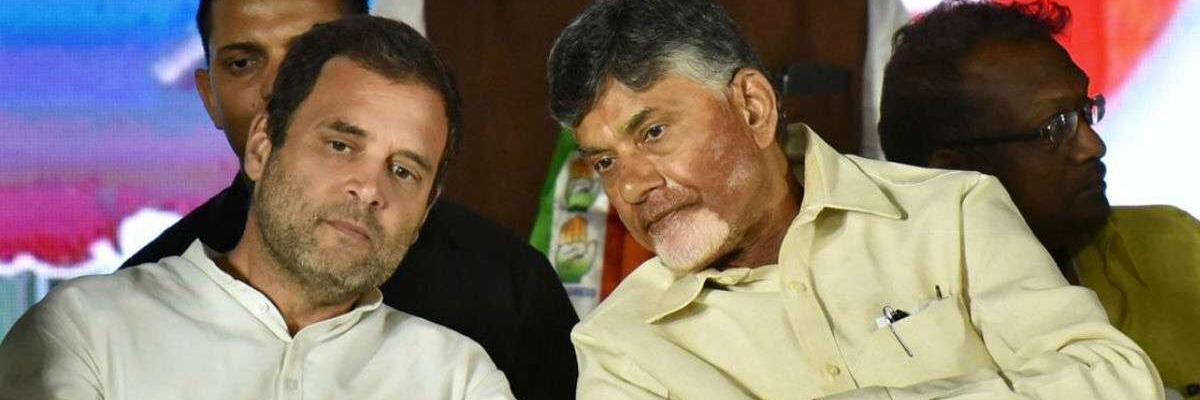Live
- Kerala LoP Satheesan urges CM Vijayan to pass resolution against draft UGC regulations
- Human Trafficking Awareness Day 2025: History, Significance, and Theme
- Hrithik Roshan reflects on legacy and inspiration
- Dhivyabharathi promises an unforgettable experience with ‘Kingston’
- India remains a bright spot in global GDP growth trajectory: Economists
- Director Kiruthiga Udhayanidhi encourages actors to embrace bold roles
- ‘Fateh’ review: Feast to action lovers
- Samantha overcomes health setbacks; shares updates on social media
- Kejriwal swindled Rs 2,026 cr through liquor scam, shows CAG report
- Angola reports 119 cholera cases, including 12 deaths
Just In

Regional political parties are Indias new electoral box offices After the historic majority to a single party in 2014, they were almost written off But now analysts speculate they will be the key to government formation after the next general elections So, the two competing national partiesthe Congress and the Bharatiya Janata Party BJP are cracking tough political equations to win over as
Regional political parties are India’s new electoral box offices. After the historic majority to a single party in 2014, they were almost written off. But now analysts speculate they will be the key to government formation after the next general elections. So, the two competing national parties—the Congress and the Bharatiya Janata Party (BJP)— are cracking tough political equations to win over as many of them as possible.
There are valid reasons for this. The 1980s and ‘90s witnessed the electoral boom of regional political parties who have been expanding both in number as well as in vote share. In fact, the number of national parties has come down. In the first Lok Sabha election in 1952, of the 55 parties that contested 18 were regional parties. The number went up to 36 in the 2004 election. In the 2014 elections, 31 regional parties sent their representatives to Parliament.
In the 1984 general election, regional parties got 11.2 per cent of the votes; in 2009, their share went up to 28.4 per cent. In the past 20 years the share of regional parties in total votes has consistently increased. For the next elections in 2019, analysts estimate regional parties will contest in 150-180 seats where the two national parties may not be significant players.
There is already a certainty in mainstream political dialogue that national parties have ceded space to regional parties. This, according to political pundits, is because the national parties have not been able to address regional “aspirations”.
The big question, therefore, is: have the regional parties lived up to this “aspiration”? Much before the 1980s when the regional parties came to national prominence, they were dominant players in many states like Jammu and Kashmir, Punjab, Odisha and Tamil Nadu.
India’s long experiment with regional parties offers little evidence to suggest that regional parties performed differently than national parties. They may have fuelled regional pride but in terms of regional development their performance hardly differed from that of national parties. Rather, regional parties now adopt and implement policies of national parties more aggressively at the State level.
The rise of regional parties was sharp in the late 1980s and ’90s when the country saw acute polarisation of voters in terms of socio-economic groups. During this period voters from the disadvantaged sections took greater part in voting. Many regional parties used this to carve out their political identity. They promised development and social and economic equity in face of economic liberalisation. Regional disparity was stark and livelihood crisis was severe at that point and regional parties emerged using developmental aspirations of millions of people.
More recently, they have flagged off the issue of federalism prominently in the face of an overarching Central government. Political analysts call their emergence democratisation of politics, where the focus shifted from national parties to local ones, allowing local issues to be reflected in national agenda. This also created many regional leaders for the country that had got used to a couple of top leaders from national parties leading and giving identity to the country. One would assume, the political direction was right.
However, changes in the political landscape notwithstanding, regional parties don’t have much to show in terms of redefining developmental policies that reflect regional aspirations. Whether it is relatively developed Tamil Nadu that elects regional parties for a long period or Odisha, India’s poorest State with a regional party in power for more than one and half decades, they do not have different economic policies to boast. Rather, there is a rush to adopt economic liberalisation, a national economic policy initiated by the Congress and supported by the other national party, the BJP.
Take, for example, Chandrababu Naidu of the Telugu Desam Party, a key player in Andhra Pradesh (both undivided and in Telangana). He could not evolve an alternative land and agricultural policy to fix regional disparity. It is the same with Odisha Chief Minister Navin Patnaik, representing the Biju Janata Dal. Under his leadership there has not been much change in the lives of the poor.
His aggressive industrialisation has led to further precipitation of regional disparity and livelihood crisis. Bihar’s ruling regional party is no different. Chief Minister Nitish Kumar has been courting investments and high GDP growth. Except sporadic land distribution programmes for the poor, there is no concrete step in the direction of fulfilling regional aspirations.
It may be too early to rate regional parties’ development performance. But it has been long enough to gauge a trend. And the trend is that regional parties are divorcing themselves from their assumed mandate of fulfilling local aspirations.
- Richard Mahapatra
(Courtesy: Down To Earth)

© 2025 Hyderabad Media House Limited/The Hans India. All rights reserved. Powered by hocalwire.com







